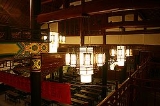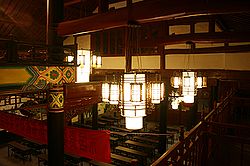
Zhejiang Fujian Meeting Hall
Encyclopedia
The Zhejiang and Fujian Meeting Hall
is a historical Qing- Dynasty
building in the City of Jinan
, Shandong
Province, China. It served as a meeting hall for traders form Zhejiang
and Fujian
living in Jinan and is the last remaining structure of its kind in the city. It illustrates the importance of Jinan as a trading center in the second half of the 19th century.
 The city of Jinan has been one of the major transportation and trading
The city of Jinan has been one of the major transportation and trading
centers in the north of China for long time, particularly so after the
Yellow River
shifted its bed to the immediate north of the city in
1852. As a consequence, traders from other regions of China came to
Jinan and established their businesses there. Groups of traders from
the same home region set up meeting halls in order to make themselves
feel at home, provide a convenient location for their business
activities, foster collaboration among themselves, and protect their
common business interests. In total, Jinan had more than 10 meeting
halls for traders from regions over the country. Over the years most
of these buildings were either converted to serve other purposes,
deteriorated, or were torn down. The meeting hall of the traders from
Zhejiang
(abbreviated as "Zhe" (浙) in the hall's Chinese name) and Fujian
(abbreviated as "Min" (闽) in the hall's Chinese name) is the last existing meeting hall in
Jinan. It was established in 1873 during the late Qing Dynasty
by
a trader from Fujian who also held a government office. Since losing its
function as a meeting hall, the building has been used as a boarding house, a morgue, as storage for
old books (1960's) and as a factory building (1970's). The building was declared a key historical
site by the City of Jinan in 1979. On October 16, 2007, the renovated hall was reopen as a center where senior citizens can practice arts such as calligraphy and painting.
festival. On these occasions, the traders from Fujian and Zhejiang
would use it for religious observances, to discuss business, to dine,
and to attend theater performances.
The meeting hall has a wooden framework supported by large wooden
pillars. Overall the building complex is about 80 meters deep and 30 meters wide
. Its roof is covered with small green tiles. Originally,
the hall had two gates, a north gate leading to the Kuan Hou Suo Alley
and a south gate leading to the Southern Ma Dao Jie (now renamed to
"Black Tiger Spring West Road"). The north gate has been closed off in
1956, since then, since then only the south gate is being used. The
meeting hall has two main halls, one located directly behind the gate
house of the southern entrance gate and the theater hall right to the
north of it. The two halls are separated by a wooden screen that can
be opened to create one big hall to accommodate large functions. The
theater hall is supported by six pillars and consists of five
half-open rooms. The stage (approximately 6 meters wide and 4 meters deep) is located to the north of the hall with
seating areas arranged along the east, west, and south sides of the
hall. Wooden staircases lead up to the first floor on the east and
west sides of the hall. Behind the stage lies a small changing room
for the actors.
District, within the historical city center of Jinan, north of the
southern city moat. It geographical coordinates are 36°39′45.72"N 117°1′30.00"E and its postal address is: Black Tiger Spring West Road Number 23 ,
Lixia District, Jinan.
is a historical Qing- Dynasty
Qing Dynasty
The Qing Dynasty was the last dynasty of China, ruling from 1644 to 1912 with a brief, abortive restoration in 1917. It was preceded by the Ming Dynasty and followed by the Republic of China....
building in the City of Jinan
Jinan
Jinan is the capital of Shandong province in Eastern China. The area of present-day Jinan has played an important role in the history of the region from the earliest beginnings of civilisation and has evolved into a major national administrative, economic, and transportation hub...
, Shandong
Shandong
' is a Province located on the eastern coast of the People's Republic of China. Shandong has played a major role in Chinese history from the beginning of Chinese civilization along the lower reaches of the Yellow River and served as a pivotal cultural and religious site for Taoism, Chinese...
Province, China. It served as a meeting hall for traders form Zhejiang
Zhejiang
Zhejiang is an eastern coastal province of the People's Republic of China. The word Zhejiang was the old name of the Qiantang River, which passes through Hangzhou, the provincial capital...
and Fujian
Fujian
' , formerly romanised as Fukien or Huguing or Foukien, is a province on the southeast coast of mainland China. Fujian is bordered by Zhejiang to the north, Jiangxi to the west, and Guangdong to the south. Taiwan lies to the east, across the Taiwan Strait...
living in Jinan and is the last remaining structure of its kind in the city. It illustrates the importance of Jinan as a trading center in the second half of the 19th century.
Historical background

centers in the north of China for long time, particularly so after the
Yellow River
Yellow River
The Yellow River or Huang He, formerly known as the Hwang Ho, is the second-longest river in China and the sixth-longest in the world at the estimated length of . Originating in the Bayan Har Mountains in Qinghai Province in western China, it flows through nine provinces of China and empties into...
shifted its bed to the immediate north of the city in
1852. As a consequence, traders from other regions of China came to
Jinan and established their businesses there. Groups of traders from
the same home region set up meeting halls in order to make themselves
feel at home, provide a convenient location for their business
activities, foster collaboration among themselves, and protect their
common business interests. In total, Jinan had more than 10 meeting
halls for traders from regions over the country. Over the years most
of these buildings were either converted to serve other purposes,
deteriorated, or were torn down. The meeting hall of the traders from
Zhejiang
Zhejiang
Zhejiang is an eastern coastal province of the People's Republic of China. The word Zhejiang was the old name of the Qiantang River, which passes through Hangzhou, the provincial capital...
(abbreviated as "Zhe" (浙) in the hall's Chinese name) and Fujian
Fujian
' , formerly romanised as Fukien or Huguing or Foukien, is a province on the southeast coast of mainland China. Fujian is bordered by Zhejiang to the north, Jiangxi to the west, and Guangdong to the south. Taiwan lies to the east, across the Taiwan Strait...
(abbreviated as "Min" (闽) in the hall's Chinese name) is the last existing meeting hall in
Jinan. It was established in 1873 during the late Qing Dynasty
Qing Dynasty
The Qing Dynasty was the last dynasty of China, ruling from 1644 to 1912 with a brief, abortive restoration in 1917. It was preceded by the Ming Dynasty and followed by the Republic of China....
by
a trader from Fujian who also held a government office. Since losing its
function as a meeting hall, the building has been used as a boarding house, a morgue, as storage for
old books (1960's) and as a factory building (1970's). The building was declared a key historical
site by the City of Jinan in 1979. On October 16, 2007, the renovated hall was reopen as a center where senior citizens can practice arts such as calligraphy and painting.
Architectural layout
The meeting hall served as a gathering place on every majorfestival. On these occasions, the traders from Fujian and Zhejiang
would use it for religious observances, to discuss business, to dine,
and to attend theater performances.
The meeting hall has a wooden framework supported by large wooden
pillars. Overall the building complex is about 80 meters deep and 30 meters wide
. Its roof is covered with small green tiles. Originally,
the hall had two gates, a north gate leading to the Kuan Hou Suo Alley
and a south gate leading to the Southern Ma Dao Jie (now renamed to
"Black Tiger Spring West Road"). The north gate has been closed off in
1956, since then, since then only the south gate is being used. The
meeting hall has two main halls, one located directly behind the gate
house of the southern entrance gate and the theater hall right to the
north of it. The two halls are separated by a wooden screen that can
be opened to create one big hall to accommodate large functions. The
theater hall is supported by six pillars and consists of five
half-open rooms. The stage (approximately 6 meters wide and 4 meters deep) is located to the north of the hall with
seating areas arranged along the east, west, and south sides of the
hall. Wooden staircases lead up to the first floor on the east and
west sides of the hall. Behind the stage lies a small changing room
for the actors.
Location
The Zhejiang and Fujian Traders Meeting Hall is located in LixiaDistrict, within the historical city center of Jinan, north of the
southern city moat. It geographical coordinates are 36°39′45.72"N 117°1′30.00"E and its postal address is: Black Tiger Spring West Road Number 23 ,
Lixia District, Jinan.

